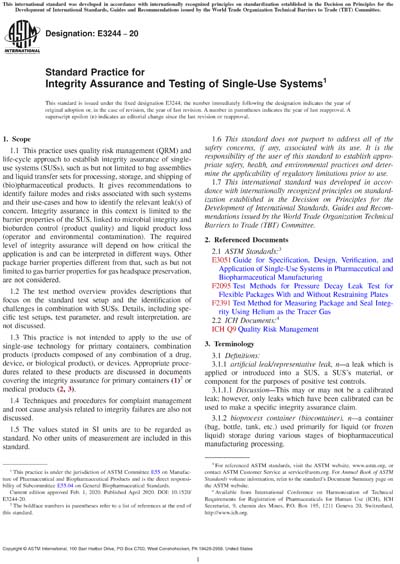Historical
ASTM E3244-20
Standard Practice for Integrity Assurance and Testing of Single-Use Systems
1.1 This practice uses quality risk management (QRM) and life-cycle approach to establish integrity assurance of single-use systems (SUSs), such as but not limited to bag assemblies and liquid transfer sets for processing, storage, and shipping of (bio)pharmaceutical products. It gives recommendations to identify failure modes and risks associated with such systems and their use-cases and how to identify the relevant leak(s) of concern. Integrity assurance in this context is limited to the barrier properties of the SUS, linked to microbial integrity and bioburden control (product quality) and liquid product loss (operator and environmental contamination). The required level of integrity assurance will depend on how critical the application is and can be interpreted in different ways. Other package barrier properties different from that, such as but not limited to gas barrier properties for gas headspace preservation, are not considered.
1.2 The test method overview provides descriptions that focus on the standard test setup and the identification of challenges in combination with SUSs. Details, including specific test setups, test parameter, and result interpretation, are not discussed.
1.3 This practice is not intended to apply to the use of single-use technology for primary containers, combination products (products composed of any combination of a drug, device, or biological product), or devices. Appropriate procedures related to these products are discussed in documents covering the integrity assurance for primary containers (1)2 or medical products (2, 3).
1.4 Techniques and procedures for complaint management and root cause analysis related to integrity failures are also not discussed.
1.5 The values stated in SI units are to be regarded as standard. No other units of measurement are included in this standard.
1.6 This standard does not purport to address all of the safety concerns, if any, associated with its use. It is the responsibility of the user of this standard to establish appropriate safety, health, and environmental practices and determine the applicability of regulatory limitations prior to use.
1.7 This international standard was developed in accordance with internationally recognized principles on standardization established in the Decision on Principles for the Development of International Standards, Guides and Recommendations issued by the World Trade Organization Technical Barriers to Trade (TBT) Committee.
ASTM International [astm]

